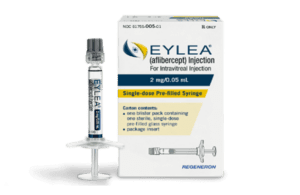
[Image courtesy of Regeneron/Bayer]
Increasing the dose of Regeneron‘s and Bayer‘s aflibercept (Eylea) to 8 mg led to sustained treatment intervals in patients with neovascular eye disease, according to the Phase 2/3 PHOTON and Phase 3 PULSAR clinical trials.
In both studies, dosing patients at the 8 mg dose level every 12 or 16 weeks achieved noninferiority compared to 2 mg every 8 weeks. The studies used best-corrected visual acuity (BCVA) in patients with diabetic macular edema (DME) and wet age-related macular degeneration (wAMD) to determine noninferiority.
Almost 90% of patients with diabetic macular edema and nearly 80% of patients with wet age-related macular degeneration were able to maintain a 16-week dosing regimen, noted Dr. David Brown, a trial investigator.
Brown notes that the studies’ favorable durability data and safety profile could make an 8 mg dose of aflibercept a standard of care for DME and wAMD.
In the following interview, Dr. Brown, who is also the director of research at Retina Consultants of Texas, provides insights into the safety and efficacy of aflibercept in the PHOTON and PULSAR trials.
Is the take-home message for the PHOTON and PULSAR studies that they could lead to a reduced treatment burden for many DME and wAMD patients?

Dr. David Brown [Image courtesy of Retina Consultants of Texas]
Brown: Absolutely. That’s the take-home message. Currently, with both AMD and DME, the big limitation is that it’s often tough for patients to come often enough to get adequately treated. With this higher dose of aflibercept, you’re seeing a significant number of patients who can go longer than we previously expected.
Patients have different drug clearance rates. It’s a bell curve. Some patients clear drugs more slowly or quickly, but by providing two additional half-lives, you’re extending the time for everyone. You don’t necessarily extend everyone to 16 weeks. But if you could get those who need it every four weeks out to six weeks, for example, that would be a huge advantage for them. You could go from 13 shots a year to about nine.
The average treatment-naive patient can probably go an extra month with this higher dose.
It can be a burden for DME and AMD patients to frequently get injections into their eye. How big of a burden is it for clinicians to treat them?
Brown: Doctors have learned to be more efficient with lean techniques, limiting patient flow, training and speeding up exams.
I don’t know many physicians who are over capacity right now. Certainly, there are National Health Service clinics in the UK and others that have capacity issues. As a result, they have to almost turn away patients.
If we widely adopt complement inhibitors for geographic atrophy, we could see some strains on the system. If the use of complement inhibitors takes off, that’s potentially a 30% or 40% increase in our injection volume. And we have one potentially going to be approved by the end of the year.
Could you say more about the endpoint of noninferiority in the PHOTON and PULSAR clinical trials?
Brown: Noninferiority is a statistical way to get a drug approved. To be honest, the lines have to be almost superimposed for us to feel that they’re noninferior clinically. Both PULSAR and PHOTON met noninferiority margins by very significant amounts. The visual acuity curves in those trials are right on top of one another.
Can you share more about how well patients in the PULSAR and PHOTON studies tolerated the larger dose of aflibercept?
Brown: You have two concerns. One, because of the solubility, we had to go to 70 μL over 50 μL, which is a little more injection than we are used to giving. Fortunately, there was no evidence of inflammation from the increased protein or intraocular pressure problems from giving this 70 μL dose. Systemically, if you give anti-VEGF agents and chemotherapy doses intravenously, you certainly see a pretty consistent hypertension signal that increases heart attacks and stroke. Hypertension is your best marker because you expect to see that if there’s an anti-hypertensive blockade systemically. And we didn’t see that. We didn’t see any increase in either hypertension events or mean overall blood pressure. So far, so good. Certainly, when it gets out in the wild, and we put it out to many more patients, we will be diligently monitoring that. But not much goes in the eye. It’s really small compared to the chemotherapy doses. So at this point, we’re cautiously optimistic that it’s safe.
Can you share more about your background in retinal vascular diseases?
Brown: We’ve had the largest clinical trials center for macular degeneration and diabetic retinopathy in the world in Houston for quite a while. I was the first author on ANCHOR, the first AMD study for Lucentis. That was featured in the New England Journal. I was the second author on the MARINA study. We were the lead recruiters for the RIDE/RISE and BRAVO ranibizumab studies for diabetic macular edema (DME) and branch retinal vein occlusion (BRVO), respectively.
All along, I thought we were not at the top of the dose-response curves. So I did a 50-patient investigator-sponsored trial with a 2 mg dose of ranibizumab that showed that these hard-to-treat patients — the ones that need shots frequently — actually did better anatomically and gained four letters over what they were on before, which was the 0.5 mg ranibizumab. This led to Genentech doing the HARBOR trial, which in a treatment-naive population didn’t seem to help. So we tested up to 4 mg of aflibercept in the Phase 1. We went with 2 mg because there were concerns early on that there might be systemic safety issues. We haven’t seen that with 55 million doses of aflibercept given worldwide.
Can you share more about how the anti-VEGF agents have transformed the treatment of DME and wet AMD?
Brown: There was nothing — I mean literally. In 1995, when I started practicing, the treatment for wet macular degeneration was lasering the lesion. So you are left with a small dark scotoma. And this was supposed to be better than waiting for a big dark scotoma. Literally, it’s analogous to amputation in Civil War medicine. You’re trying to cut off the arm at the elbow, so you save it up to the shoulder. Visudyne (verteporfin) wasn’t much better. You had about 6% of people with improved vision. You didn’t really gain vision. You just lost vision slower.
Anti-VEGF totally changed the way we treat AMD. It went from a blinding condition to a manageable condition if you can get patients to come in. In the 17 years we’ve had anti-VEGFs in the clinic, we’ve been looking for better mousetraps. Certainly, aflibercept was incrementally better than ranibizumab 0.5 mg. We think that aflibercept 8 mg is an additional step in the right direction of developing better agents for our patients. Same thing in diabetic macular edema.
Laser really didn’t improve your vision. It just kind of limited your losses. Anti-VEGF totally changed that with consistent gains in visual acuity that are maintained. It has changed patients’ lives with diabetic macular edema and age-related macular degeneration.
Can you share more about your work at the Retina Consultants of Texas?
Brown: The goal is to continue the fight against blindness. We’ve made huge advances in very common diseases — macular degeneration and diabetic macular edema, but it’d be great to eliminate these diseases. We’re certainly working on gene therapies that potentially make continuous anti-VEGF. We are working on a bunch of trials for inherited retinal diseases like retinitis pigmentosa, Stargardt’s Disease and other blinding conditions that currently don’t have effective treatments. We’ve made some big successes, but we have a lot of work to do in the field.